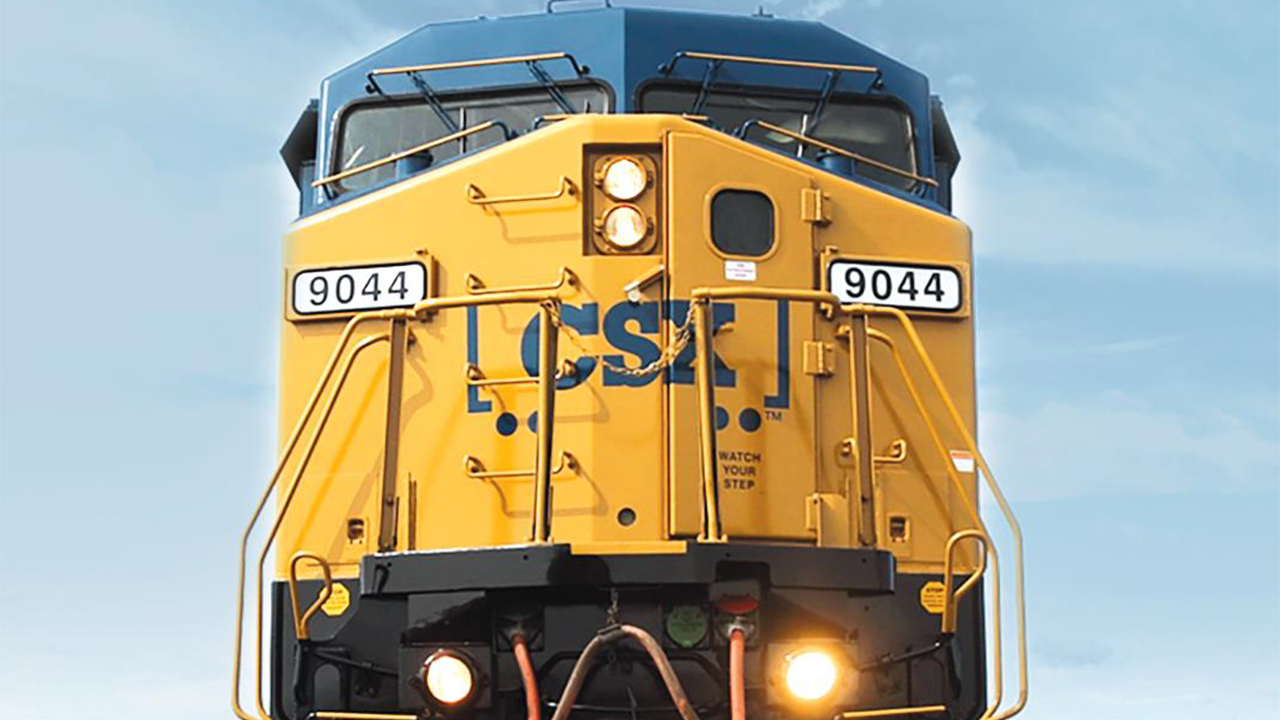
STB Scales Back CSX Reporting Requirements
Written by William C. Vantuono, Editor-in-Chief
CSX photo
The Surface Transportation Board on May 2 extended its temporary service metrics and employment reporting period for the “Big 4” Class I’s—BNSF, CSX, Norfolk Southern and Union Pacific—to Dec. 31, 2023, but modified reporting CSX’s requirements, exempting the railroad from submitting biweekly service progress reports and trainee information in monthly employment data figures.
“CSX has been meeting most of its targets for service improvement on a consistent basis,” STB noted in Docket No. EP 770, Sub-No. 1 (downloadable below). “With few exceptions, CSX has exceeded its velocity, terminal dwell, TPC (trip plan compliance), and FMLM (first mile/last mile) targets in recent months. With respect to TPC in the four most recent weeks, CSX has fluctuated above and below its targets for some unit train traffic (ethanol and grain), but exceeded its TPC targets for other types of traffic. CSX’s recent data shows that its performance generally has improved. For labor force targets, CSX stated that it expects to have 7,000 to 7,500 T&E (train and engine service) employees over the next one to two years, 4,905 MOW (maintenance-of-way) employees in one year, and 2,451 MOE (maintenance of equipment) employees in one year. Although CSX has not yet achieved its MOW target, it has met its T&E and MOE targets when compared to March 2023 monthly employment data.”
“This is a clear affirmation from the STB of CSX’s leading service performance among the four U.S. Class I’s and a direct result of our focus on improving the work experience of our railroaders and improving the reliability and overall quality of the service we provide to our customers,” CSX Vice President Corporate Communications Bryan Tucker told Railway Age.
“BNSF, NS and UP performance data show continued service challenges relative to the targets the carriers set for their own service improvement by the end of the current temporary reporting period,” STB noted. “While data submitted in recent weeks show some improvement for some performance indicators, these carriers generally are not meeting their service performance targets on average. Therefore, and because service issues continue to affect the network, the Board finds that it must continue to monitor service performance and hiring efforts.”
BNSF “has failed to achieve almost all of its one-year service targets for key performance indicators in recent weeks,” STB stated. “BNSF has met its train velocity and average trains holding per day targets just once in the past four weeks. Data for the four most recent weeks also show that BNSF has stayed well above its terminal dwell target and that, on average, cars are sitting in yards longer than when BNSF provided its December 2022 Interim Update. Further, recent data show a troubling regression below service levels reported by BNSF in early December. With respect to OTP (on-time performance), BNSF has exceeded its targets for intermodal and automotive unit traffic in recent weeks. However, but for rare occasions, BNSF has not met its targets for other unit train categories or merchandise traffic in recent weeks. When compared to the March 2023 monthly employment data for employees actively on the job, BNSF has not yet met any of its one-year labor force targets, although it is close to meeting its MOE target. When compared to Form C data, BNSF has met its one-year labor targets.”
NS “has occasionally met its targets for velocity and on-time delivery since filing its December 2022 Interim Update,” STB said. “In recent weeks, however, NS has not met its targets for any key performance indicator. According to NS, several unrelated factors have combined to negatively affect the quality of service over the past several weeks, leading to ‘a short-term disruption in terminal dwell and train speed in the merchandise and bulk networks.” NS has met its one-year T&E and MOW targets when compared to March 2023 monthly employment data submitted in this docket. NSR has not met its MOE target.”
“In recent weeks, UP has exceeded its target for FMLM and its operating inventory has been below its target, signifying that it has made some positive steps toward reducing network congestion,” STB stated. “However, UP’s four most recent biweekly progress reports indicate that performance is below its target for car velocity on average and that it has met its target for cars per carload just once. With respect to TPC in recent weeks, UP has met its target for coal unit on average, but UP’s performance has been below its targets for other traffic on average. UP’s March 2023 monthly employment data for employees actively on the job indicates that UP is close to meeting its labor force targets, but has not yet met any of them.”
“It is ordered that BNSF, NS and UP shall continue to submit biweekly service progress reports until Dec. 31, 2023,” STB concluded. “All Class I railroads shall continue to submit weekly performance data and monthly employment data until [then]. Nothing in this decision should be construed to suggest that the Board finds that the six-month or one-year targets set by any of the Four Carriers are sufficient to resolve the problems currently plaguing the national rail system. These targets were meant to be interim goals, not ultimate goals. Significantly more progress will be needed from each of the carriers to abate the rail service issues that prompted the Board to open this proceeding.”



